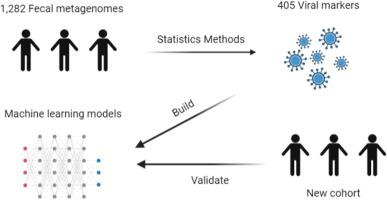Journal of Advanced Research ( IF 11.4 ) Pub Date : 2022-10-02 , DOI: 10.1016/j.jare.2022.09.012 Fang Chen 1 , Shenghui Li 2 , Ruochun Guo 2 , Fanghua Song 3 , Yue Zhang 2 , Xifan Wang 4 , Xiaokui Huo 5 , Qingbo Lv 2 , Hayan Ullah 6 , Guangyang Wang 6 , Yufang Ma 6 , Qiulong Yan 6 , Xiaochi Ma 5

|
Introduction
Viruses have been reported as inducers of tumorigenesis. Little studies have explored the impact of the gut virome on the progression of colorectal cancer. However, there is still a problem with the repeatability of viral signatures across multiple cohorts.
Objectives
The present study aimed to reveal the repeatable gut vial signatures of colorectal cancer and adenoma patients and decipher the potential of viral markers in disease risk assessment for diagnosis.
Methods
1,282 available fecal metagenomes from 9 published studies for colorectal cancer and adenoma were collected. A gut viral catalog was constructed via a reference-independent approach. Viral signatures were identified by cross-cohort meta-analysis and used to build predictive models based on machine learning algorithms. New fecal samples were collected to validate the generalization of predictive models.
Results
The gut viral composition of colorectal cancer patients was drastically altered compared with healthy, as evidenced by changes in some Siphoviridae and Myoviridae viruses and enrichment of Microviridae, whereas the virome variation in adenoma patients was relatively low. Cross-cohort meta-analysis identified 405 differential viruses for colorectal cancer, including several phages of Porphyromonas, Fusobacterium, and Hungatella that were enriched in patients and some control-enriched Ruminococcaceae phages. In 9 discovery cohorts, the optimal risk assessment model obtained an average cross-cohort area under the curve of 0.830 for discriminating colorectal cancer patients from controls. This model also showed consistently high accuracy in 2 independent validation cohorts (optimal area under the curve, 0.906). Gut virome analysis of adenoma patients identified 88 differential viruses and achieved an optimal area under the curve of 0.772 for discriminating patients from controls.
Conclusion
Our findings demonstrate the gut virome characteristics in colorectal cancer and adenoma and highlight gut virus-bacterial synergy in the progression of colorectal cancer. The gut viral signatures may be new targets for colorectal cancer treatment. In addition, high repeatability and predictive power of the prediction models suggest the potential of gut viral biomarkers in non-invasive diagnostic tests of colorectal cancer and adenoma.
中文翻译:

粪便病毒组的荟萃分析表明肠道病毒特征对于结直肠癌和腺瘤风险评估具有很高的诊断潜力
介绍
据报道,病毒是肿瘤发生的诱导剂。很少有研究探讨肠道病毒组对结直肠癌进展的影响。然而,多个队列中病毒特征的重复性仍然存在问题。
目标
本研究旨在揭示结直肠癌和腺瘤患者的可重复肠道小瓶特征,并破译病毒标记物在疾病风险评估诊断中的潜力。
方法
从 9 项已发表的结直肠癌和腺瘤研究中收集了 1,282 个可用的粪便宏基因组。通过独立于参考的方法构建肠道病毒目录。通过跨队列荟萃分析来识别病毒特征,并用于构建基于机器学习算法的预测模型。收集新的粪便样本以验证预测模型的概括性。
结果
与健康人相比,结直肠癌患者的肠道病毒组成发生了巨大变化,部分管状病毒科和肌病毒科病毒的变化以及微病毒科病毒的富集证明了这一点,而腺瘤患者的病毒组变异相对较低。跨队列元-分析确定了 405 种结直肠癌差异病毒,包括在患者体内富集的卟啉单胞菌属、梭杆菌属和 Hungatella 的几种噬菌体以及一些对照富集的瘤胃球菌科噬菌体。在 9 个发现队列中,最佳风险评估模型获得了 0.830 的曲线下平均跨队列面积,用于区分结直肠癌患者和对照组。该模型还在 2 个独立验证队列中表现出一致的高精度(最佳曲线下面积,0.906)。对腺瘤患者的肠道病毒组分析鉴定出 88 种差异病毒,并实现了区分患者和对照的最佳曲线下面积 0.772。
结论
我们的研究结果证明了结直肠癌和腺瘤中的肠道病毒组特征,并强调了肠道病毒-细菌在结直肠癌进展中的协同作用。肠道病毒特征可能是结直肠癌治疗的新靶点。此外,预测模型的高重复性和预测能力表明肠道病毒生物标志物在结直肠癌和腺瘤的非侵入性诊断测试中的潜力。











































 京公网安备 11010802027423号
京公网安备 11010802027423号